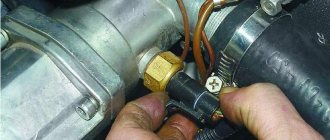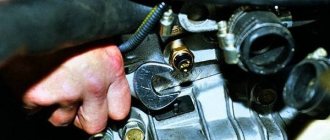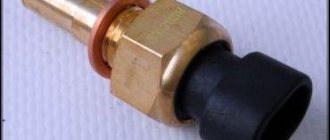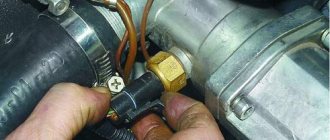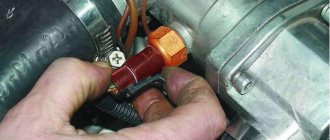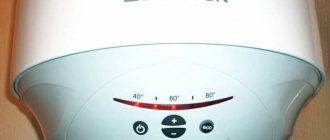Each car engine is equipped with a device for measuring the temperature of the power unit. This component allows the driver to detect overheating in time and eliminate this problem. What is the fan switch on sensor on a VAZ 2109 with a carburetor engine, what is its structure and how to replace it - read on.
[ To uncover]
[Hide]
What symptoms indicate problems with the sensor?
During long-term operation of the car, obvious and indirect signs may be observed indicating problems with the temperature sensor or its electrical circuit. The first ones directly indicate the need to check the functionality of the device:
- The engine heating indicator on the dashboard stopped working;
- the cooling fan stopped turning on, although the engine water jacket had already warmed up to 100 °C;
- antifreeze leakage from under the part body;
- The fan starts at random, including when the engine is cold.
If your car exhibits the listed signs of a malfunction of the coolant temperature sensor, then feel free to proceed to diagnosing it and fixing the problem, which will be discussed below. Indirect symptoms may indicate a breakdown of the meter or other elements of the cooling system or power unit. Here are the most common ones:
- Cold starting of the engine is difficult. The car starts, but immediately stalls, you need to make several repeated attempts. The cause may be a thermocouple, throttle position sensor, insufficient compression or ignition problems.
- Unstable operation at idle. In addition to the temperature meter, it is affected by the serviceability of the spark plugs, mass flow sensor, injectors and many other factors.
- The temperature is within normal limits, but the coolant begins to boil. If the thermostat fails or the level of antifreeze in the jacket decreases, then the readings of the device may differ from the real state of affairs.
The serviceability of an electronic temperature meter can be checked at home. If indirect symptoms of a malfunction are observed, the test will help to identify them or exclude them from a number of parts that are “under suspicion.” If you successfully check the problem, you will have to look elsewhere or contact the nearest auto repair shop.
The temperature needle jumps when the thermostat and DTOZh are working
In some cases, it happens that the thermostat, as well as the temperature sensor and wiring, turn out to be working. In this case, the temperature arrow jumps arbitrarily, overestimating or underestimating the readings, in an arbitrary range.
Often the problem lies in the electronic board of the instrument panel. If the soldering of such a board turns out to be of poor quality, problems arise after a few years. The malfunction can be eliminated by disassembling the shield and re-soldering. As part of such work, special attention should be paid to resistors and output mass. If you plan to do the work yourself, you need to have a low-power soldering iron with a thin rod.
We also note that the needle, with other elements in good working order, both mechanically and electrically, can jump if the engine cooling system is airy. In other words, the air in the cooling system forms an air lock. This plug heats up much faster and more strongly than antifreeze or antifreeze.
As a result, the sensor reacts to changes in temperature, the pointer arrow changes position chaotically. At the same time, the air in the system is indirectly indicated by the fact that liquid is leaking from under the cap of the expansion tank, there may be a noticeable decrease in the level in the tank, etc.
Where is the fan switch located?
On all VAZ cars with a carburetor engine, the fan switch sensor is located on the radiator housing. That is, to find this device, just open the hood and find a mechanism similar to a nut with contacts on the side of the cooling radiator.
Heating the threaded part directly in the coolant leads to the closure of the contacts. In turn, the voltage from the battery is supplied to the electric motor, which drives the fan.
Video “Visual instructions for replacing the device”
You can learn how to replace the sensor yourself at home from the video below (the author of the video is Thoughts and advice from Mustafa Murtazaev).
VAZ 2109 and 21099 cars are equipped with a variety of sensors and regulators designed to ensure proper operation of the power unit as a whole. One of such devices is the sensor for turning on the VAZ 2109 carburetor fan, as well as the DTOZH - antifreeze temperature controller. Find out more about the devices in this article.
Malfunctions
There are several main malfunctions that lead to failure of the coolant temperature sensor. Namely:
- There is an electrical contact inside the sensor that may break or become cracked. If the contact is broken, this leads to complete combustion of the regulator. If there are cracks, the sensor can still function, but the lack of proper contact does not allow accurate information about the coolant to be transmitted;
- Sensor insulation is broken. If the wiring insulation is poor, short circuits occur. They, in turn, cause the device to burn out;
- Wires break near the sensor. Because of this, the regulator cannot turn on the fan, which leads to overheating of the car.
In the summer, a failure in the operation of the diesel engine is rarely noticed, but in winter it becomes much more difficult to start the engine.
Signs of breakdown
How can you determine that the coolant temperature sensor has stopped working normally or has completely burned out?
- The cooling fan turns on randomly even at normal engine temperature. But in fact, the fan should only turn on when the power unit overheats.
- It's difficult to start the engine when it's hot. The cooling system is responsible for regulating the temperature, but a faulty sensor does not allow obtaining objective data and a signal to start a particular operating mode.
- Fuel consumption increases noticeably. This is caused by overloading the engine, which has to drive at elevated temperatures. Because of this, fuel consumption is increasing.
Before making final conclusions regarding the breakdown or malfunction of the DTOZH on the VAZ 21099, be sure to carry out verification activities.
Coolant temperature sensor for VAZ 2109 and 21099 cars
Location of the coolant sensor in the VAZ 2109
First, it is advisable to know where the engine temperature sensor is located. On models 2108, 21099 and VAZ 2109, the coolant temperature sensor is installed between the cylinder head and the thermostat, in the exhaust pipe.
Device and principle of operation
The engine temperature controller itself is a thermistor-resistor device characterized by a negative temperature coefficient. The resistance parameter itself can be measured only when the temperature decreases or increases.
When the power unit heats up as a result of operation, the resistance indicator decreases; if the engine cools down, this parameter increases. For example, at the operating temperature of the engine on a VAZ 2109, the resistance is equal to 180 Ohms, and if it is 40 degrees cold outside, then the resistance will be equal to 100,700 Ohms. On one side of the DTOZH VAZ 2109 injector there are two contacts, and on the other there is a sensitive component, which is located directly in the flow of consumables.
As for the principle of operation, when the driver turns on the ignition, the control unit transmits voltage to the regulator via a resistor. Since the DTOZH itself is a thermistor, the voltage supplied from the control unit changes immediately taking into account the temperature of the consumable. When the parameter decreases, the unit analyzes the temperature and, in accordance with these data, determines the required volume of gasoline for injection. As the power unit warms up, the volume of gasoline that is transferred to the cylinders will decrease.
Two antifreeze temperature sensors for VAZ
In addition to starting, according to the readings of the regulator, the ECU adjusts the operation of the power unit at idle speed. As a result, he independently makes decisions on enriching the combustible mixture at high and medium loads on the internal combustion engine. This indicator can be changed depending on the ignition timing.
There are two temperature sensors on a carburetor car. One turns on the fan, the other is responsible for indicating the temperature on the dashboard.
Possible faults
There are several reasons why the regulator on the VAZ 21099 refuses to work.
So, why DTOZH does not work:
- An electrical contact is located inside the device structure. Over time, this contact may simply break or cracks may form on it. If a break occurs inside the structure, this may cause complete failure. That is, the DTOZH will simply burn out. If there are cracks on the contact, the DTOZH, in principle, can work, but as a result of the lack of normal contact, the regulator will transmit incorrect data about antifreeze.
- Poor device insulation. If the insulation is broken, short circuits may occur in the operation of the device. Accordingly, ultimately, these short circuits can lead to the DTOZH, again, burning out and having to be replaced.
- There was a broken wire near the regulator. As a result of the break, the regulator will not be able to activate the fan designed to cool the power unit. Accordingly, this will lead to the engine overheating and may even boil (the author of the video is a Mechanical Technician).
How can a car owner understand that the DTOZh is out of order and it’s time to replace it?
To do this, it is enough to know about the main signs of problems, which we will discuss below:
- The fan designed to cool the engine can turn on randomly at any time. In particular, the driver should be wary that the fan turns on when the engine is not completely warmed up. Remember that the fan should always function when the internal combustion engine is overheated.
- The driver has difficulty starting a warmed-up internal combustion engine. The cooling system should automatically adjust the temperature, but because the unit is faulty, it cannot receive the correct signal.
- If you carefully monitor the operation of the car, you will notice that gasoline consumption has increased. The increase in consumption is due to the fact that the car is simply overloaded when running on a hot internal combustion engine.
- If the device fails completely, the gauge on the dashboard will show an incorrect temperature signal. A ten-minute drive is enough to warm up the engine. If after 10 minutes the temperature has not risen to the optimal temperature or when starting the internal combustion engine, the dashboard shows overheating, this indicates a malfunction.
Description of DTOZH and DVV
Where is the coolant temperature and fan activation sensor located in 2109 with an injector or carburetor engine, what should I do if the device does not work? First, let's look at the basic questions regarding the purpose, device and principle of operation.
Purpose and functions
The main purpose of the DVV is to activate and deactivate the ventilation device on the engine radiator in order to cool the power unit. The device turns the fan on and off based on the temperature of the liquid in the cooling system. On injection machines, this is DTOZH; turning the fan on and off is controlled by the brain according to the readings of this sensor.
As for the TOZh controller in the VAZ 21093, this device is intended to display readings about the antifreeze temperature on the car’s dashboard in the cabin. With its help, the driver can find out about possible overheating of the power unit.
Location
As for the location, in models 2108, 2109 and 21099 the DTOZH is located between the engine cylinder head and the thermostat, in particular, on the intake hose. The DVV is installed in the threaded hole of the expansion tank with coolant. If you look in the direction of travel of the car, the refrigerant container is installed on the right.
Principle of operation
First, let's look at the operating principle of the antifreeze temperature controller. This device is a thermistor-resistor that operates with a negative coefficient. The amount of resistance in this case can be measured as a result of a decrease or increase in the temperature range. When the car engine heats up, the resistance on the device decreases, and when the power unit cools down, this value increases. For example, when the engine is fully warmed up, the resistance value on the device is 180 Ohms, and at low negative temperatures (-40 degrees) this figure will increase to 100,700 Ohms.
When the driver activates the ignition by turning the key in the lock, the control module (ECU) begins to supply voltage to the controller using a resistor. The DTOZH itself, as mentioned above, is a thermistor; accordingly, the incoming voltage will change in accordance with the temperature of the liquid. When this value decreases, the control module analyzes this, according to which the required volume of fuel for injection into the cylinders is determined. As the car engine warms up, the volume of fuel used for injection will drop.
As for the DVV, it is installed in the negative cable gap, which is connected to the ventilator activation relay in the fuse box. When the temperature value increases to 99 degrees, a short circuit occurs at the controller contacts due to the bimetallic plate. As a result, the current through the device flows to a relay located in the block, from where it is supplied to the electric motor of the device on the fan, ultimately activating the latter (the author of the video is the AndRamons channel).
In “Nines” produced after 1998 and equipped with safety blocks from the VAZ 2114, there is no relay in this section of the circuit. Therefore, the regulator itself is also mounted in the gap of the negative cable, but only the one that is connected directly to the fan. In this case, the closure occurs at a similar temperature. If the antifreeze cools, the plate opens the contacts, causing the electric motor to turn off.
Performance test
To check the thermal sensor, it will have to be removed from the car. To do this, follow these steps:
- Allow the engine to cool to 40-50 °C to avoid burning your hands during operation. Partially or completely drain the antifreeze from the cooling system.
- Disconnect the battery from the on-board power supply by removing the negative cable.
- Disconnect the block with wires from the thermoelement.
- Unscrew the part using a wrench of the appropriate size.
If the device is installed at the top point of the system, then it is not necessary to empty it entirely; it is enough to drain a third of the liquid into the container. All antifreeze must be drained when the thermocouple is located at the bottom of the radiator.
To carry out the tests you will need:
- a multimeter or other device capable of measuring circuit resistance;
- a small container for water (you can use a regular glass);
- thermometer with a scale up to 100 °C.
A thermometer is essential if you want to make accurate resistance measurements by referring to the reference chart for your vehicle. When there is no table, the serviceability of the part is checked without a thermometer according to its operating principle: the hotter the water in the glass, the lower the resistance at the contacts should be.
Before checking the coolant temperature sensor under heating, test its contacts with an ohmmeter. It may happen that the device has burnt out or has a short circuit. Then further manipulations become meaningless and the element must be changed, since it cannot be repaired.
If the multimeter shows a certain resistance, then immerse the thermocouple in a glass of cold water and record the readings. Then add hot water and watch the resistance change, it should decrease. If there are no changes, purchase and install a new temperature sensor.
If the tests were successful and the device changes resistance when heating the water, then it is worth checking the connecting wires and cleaning the contacts. Little things like this often cause major problems.
Sensor check
When driving at high speed, the engine cools naturally. In hot weather and at low speeds, the motor may overheat. An increase in the instrument panel temperature may indicate that the sensor has failed. The device comes into operation when the coolant temperature reaches high values.
To diagnose it, it is absolutely not necessary to go to a service station. It is enough to arm yourself with a handy tool and do the following work:
- Check the fuse for operability; if it fails, then install a new one;
- Close the contacts of the mechanism; if the fan starts working, then most likely the switch on sensor needs to be replaced;
- Check the wiring, which in most cases is the cause of lack of power and ground faults.
There is also an alternative way to check the functionality of the mechanism using a multimeter. To do this, you need a container with liquid and a heat source. The first step is to disconnect all electrical connectors of the sensor and unscrew the mechanism with a key. You should first drain the antifreeze and do the work on a cold engine. The principle of checking the serviceability of the DVV is similar to checking the thermostat.
The multimeter terminals are connected to the contacts of the thermal switch and the device is switched to the “ringing” operating mode. The fan sensor is placed in a container of water with the threaded part. Then the heat source is turned on and the water is heated. The temperature range for turning on the mechanism is usually displayed on the device body. This is often between 85 and 92 degrees. When the water is heated to these values, the sensor should make a sound characteristic of its activation. If nothing happens, then the failed mechanism should be replaced.

